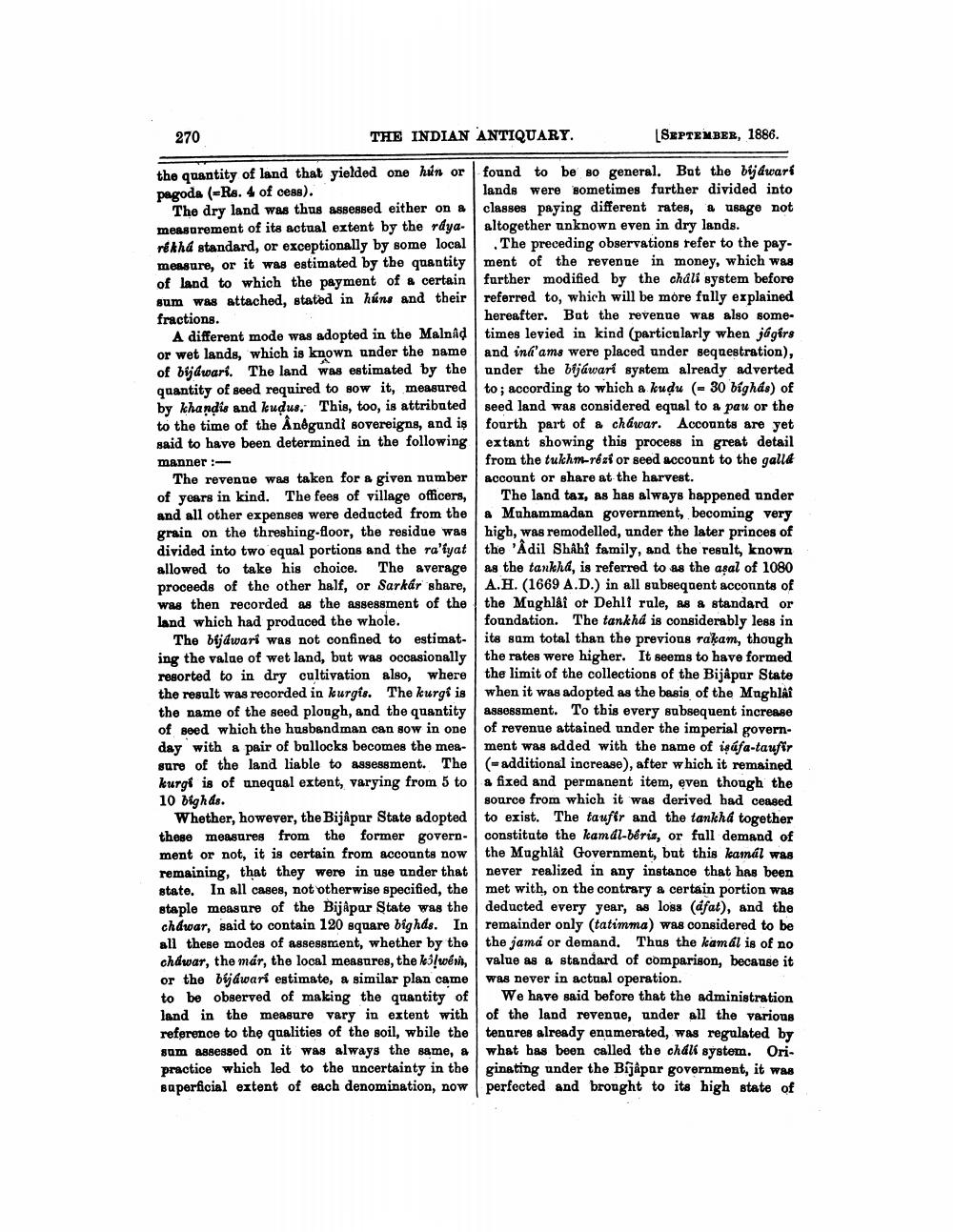________________
270
THE INDIAN ANTIQUARY.
SEPTEMBER, 1886.
the quantity of land that yielded one han or found to be so general. But the bijawari pagoda (=Rs. 4 of ceas).
lands were sometimes further divided into The dry land was thus assessed either on a classes paying different rates, & usage not measurement of its actual extent by the rdya. altogether unknown even in dry lands. rékhá standard, or exceptionally by some local The preceding observations refer to the pay. measure, or it was estimated by the quantityment of the revenue in money, which was of land to which the payment of a certain further modified by the chali system before sum was attached, stated in húns and their referred to, which will be more fully explained fractions.
hereafter. But the revenue was also someA different mode was adopted in the Malnad times levied in kind (particularly when jágers or wet lands, which is known under the name and inl'ams were placed under sequestration), of bijawari. The land was estimated by the under the bljkwari system already adverted quantity of seed required to sow it, measured to; according to which a kudu (-30 bighas) of by khandis and kudus. This, too, is attributed seed land was considered equal to a pau or the to the time of the Ånêgundi sovereigns, and is fourth part of a chawar. Accounts are yet said to have been determined in the following extant showing this process in great detail manner :
from the tukhm-rezi or seed account to the gall& The revenue was taken for a given number account or share at the harvest. of years in kind. The fees of village officers, The land tax, as has always happened under and all other expenses were deducted from the a Muhammadan government, becoming very grain on the threshing-floor, the residue was high, was remodelled, under the later princes of divided into two equal portions and the ra'iyat | the 'Adil ShAhi family, and the result, known allowed to take his choice. The average as the tankhd, is referred to as the aşal of 1080 proceeds of the other half, or Sarkar share, | A.H. (1669 A.D.) in all subsequent accounts of was then recorded as the assessment of the the Mughlái of Dehlt rule, as a standard or land which had produced the whole.
foundation. The tankhd is considerably less in The bijdwari was not confined to estimat- its sum total than the previous rakam, thongh ing the value of wet land, but was occasionally the rates were higher. It seems to have formed resorted to in dry cultivation also, where the limit of the collections of the Bijapur State the result was recorded in kurgis. The kurgi is when it was adopted as the basis of the Maghlai the name of the seed plough, and the quantity assessment. To this every subsequent increase of seed which the husbandman can sow in one of revenue attained under the imperial governday with a pair of bullocks becomes the mea- ment was added with the name of isáfa-taufir sure of the land liable to assessment. The (-additional increase), after which it remained kurgi is of unequal extent, varying from 5 to a fixed and permanent item, even though the 10 bighds.
source from which it was derived had ceased Whether, however, the Bijapur State adopted to exist. The taufir and the tankhá together these measures from the former govern- constitute the kam dl-béria, or full demand of ment or not, it is certain from accounts now the Mughlâl Government, but this kamál was remaining, that they were in use under that never realized in any instance that has been state. In all cases, not otherwise specified, the met with, on the contrary a certain portion was staple measure of the Bijapur State was the deducted every year, as logs (dfat), and the chdwar, said to contain 120 square bighds. In remainder only (tatimma) was considered to be all these modes of assessment, whether by the the jamá or demand. Thus the kamal is of no cháwar, the már, the local measures, the kwen,value as a standard of comparison, because it or the býjawari estimate, a similar plan came was never in actual operation. to be observed of making the quantity of We have said before that the administration land in the measure vary in extent with of the land revenue, under all the various reference to the qualities of the soil, wbile the tendres already enumerated, was regulated by som assessed on it was always the same, a what has been called the chali system. Oripractice which led to the uncertainty in the ginating under the Bíjâpar government, it was Baperficial extent of each denomination, now perfected and brought to its high state of




